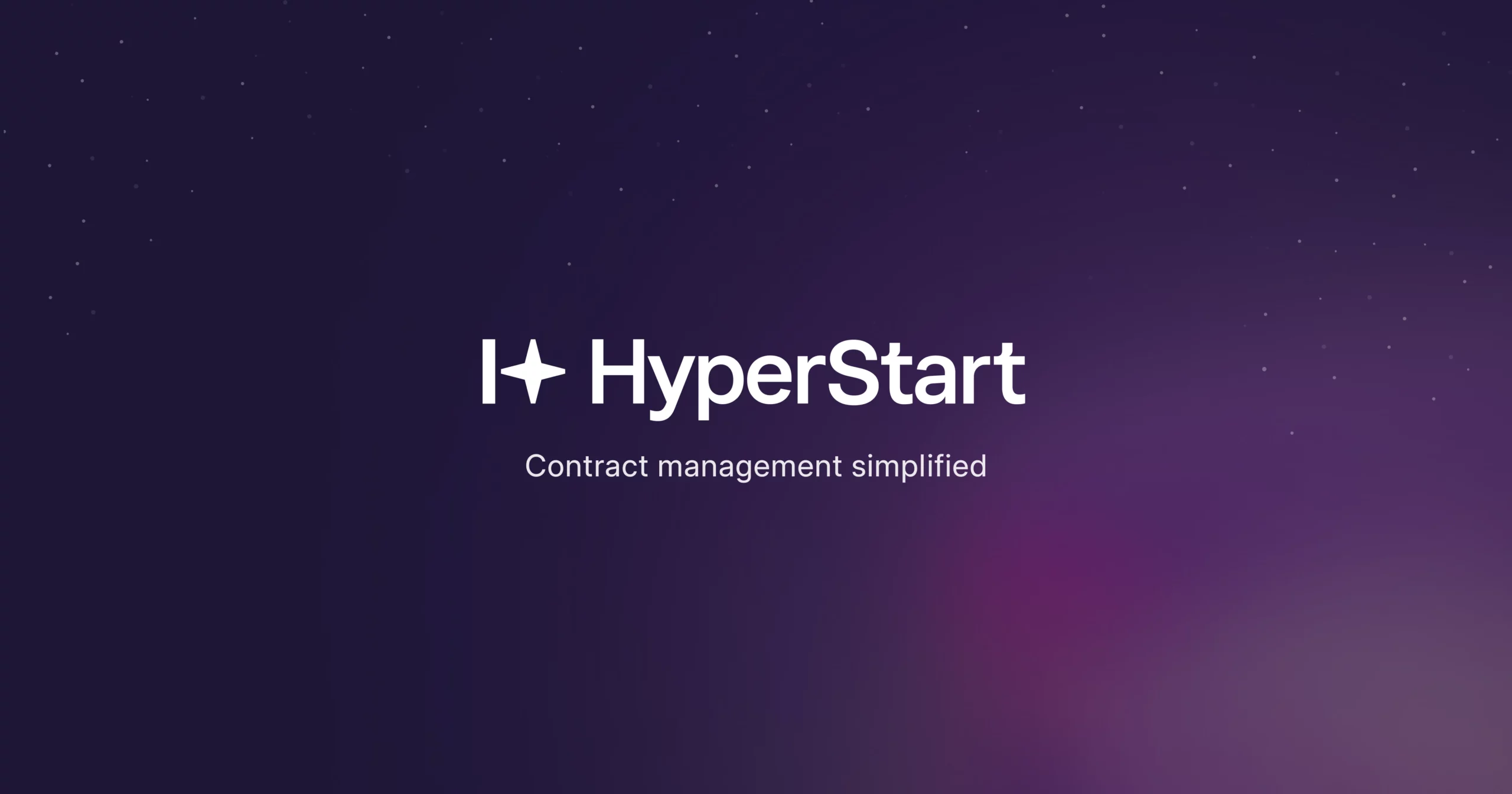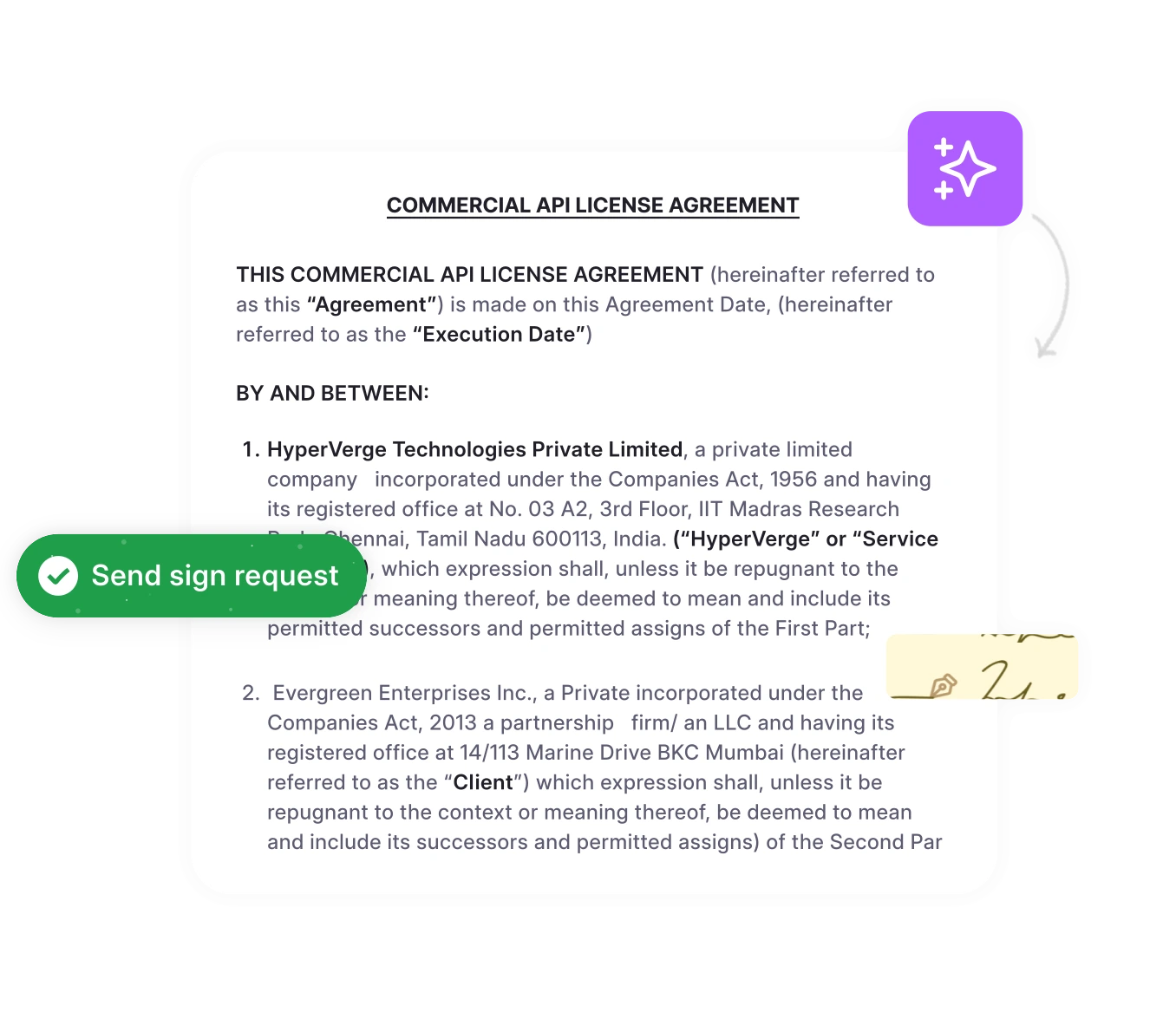Every contract begins with a promise – to customers, vendors, hires, or partners. But before that promise becomes progress, there’s one critical gate: the contract review.
And that’s often where everything slows to a crawl.
Legal teams get overwhelmed. Business units are left waiting. Sales deals prolong. Procurement is held up. HR onboarding gets pushed back.
Why?
Manual contract review is time-consuming, inconsistent, and risky.
Even a minor oversight, such as a vague renewal clause or a missing indemnity, can lead to compliance issues, revenue loss, or reputational damage.
This guide walks you through:
- What is AI contract review?
- Why are manual reviews holding your business back?
- How AI integrates with your current tools and workflows
- How can teams in sales, procurement, finance, and HR streamline their contract process with AI?
Before we understand how AI transforms contract workflows, let’s start with a clear definition of what AI contract review is and how it fits into modern legal operations.
What is AI contract review?
AI contract review is the use of artificial intelligence to automatically analyze, interpret, and flag potential risks in legal contracts before they’re signed.
Instead of going through every clause manually, AI speeds up the process using technologies like natural language processing (NLP) and machine learning (ML). AI-powered contract review software helps legal and business teams spot key terms, identify unusual language, and highlight risky clauses within seconds.
Unlike basic contract automation, AI-driven contract review is designed for high-volume, high-variance agreements, helping teams reduce bottlenecks, maintain compliance, and increase contract velocity.
Here’s a look at the core technologies behind it:
- Natural Language Processing (NLP)
It helps the AI models “read” contracts like humans, understanding meaning, tone, and legal context.
- Machine Learning (ML)
Trains the system on thousands of customer contracts so it can detect standard clauses, unusual terms, and red flags with increasing accuracy.
- Optical Character Recognition (OCR)
Converts scanned or image-based documents into readable, searchable text, unlocking old contract data and PDFs buried in your system.
Now that we understand what AI contract review does, let’s look at the challenges businesses face with traditional, manual contract reviews and how AI directly addresses them.
Breaking the manual contract review bottleneck with AI
If you’re part of a legal team, sales, HR, or procurement, you’ve likely felt the pressure that comes with reviewing contracts manually.
According to Gartner, legal departments are facing rising workloads without increased headcount, making AI-driven tools essential to scaling contract review efficiently.
Here’s why the manual process breaks down and how AI helps you fix it:
1. Too many contracts, too little time
Manual contract review can take anywhere from a few hours to several days, especially when you’re dealing with multi-page MSAs, vendor agreements, or partnership contracts. Legal departments are often understaffed, juggling hundreds of agreements, and don’t have the bandwidth to respond to every request instantly.
And for business teams? That delay means missed opportunities. Sales reps lose momentum. Vendors are kept waiting. HR can’t send offers to procurement stalls on onboarding.
Every delay adds up, and so does the cost.
AI tools scan full documents in seconds, identify key clauses, and highlight areas of concern. Legal can prioritize critical reviews and fast-track approvals, reducing delays across Sales, HR, Procurement, and more.
2. The inescapable risk of human error
Contracts are filled with dense legal language, and essential terms aren’t always easy to spot. A small oversight, like a missing indemnity clause or a vague renewal term, can lead to financial risks, compliance issues, or disputes down the line.
Even highly experienced legal professionals are human. They’re working under tight deadlines, balancing competing priorities, and reviewing dozens of similar-looking documents. Mistakes are inevitable.
And when every mistake could cost the company thousands or damage relationships with business partners, the risk becomes a real concern.
AI contract management tools are trained on thousands of contracts to identify risky terms, vague language, or missing clauses. As a second pair of eyes, it spots red flags instantly while still allowing for human oversight and critical judgment where needed.
3. Routine reviews pile up on the legal’s plate
Legal teams often become the choke point in the contract review process. Sales wants to close. Finance wants to check the payment terms. Procurement wants vendor approval. But legal teams are swamped, and routine reviews sit in the queue.
This constant dependency slows down the business and overburdens legal with repetitive, low-risk work that doesn’t require deep legal analysis.
AI can auto-classify contracts by risk and complexity, handle first-pass reviews for routine agreements, and gatekeep only the contracts that need legal expertise. This frees up legal teams to focus on what truly matters.
4. Inconsistency breeds uncertainty
Different reviewers naturally bring different perspectives in substance and style. One person might flag a missing clause. Another might not. One might escalate a red flag; another might accept it. This lack of standardization introduces legal uncertainty and often results in contracts going out with inconsistent risk profiles.
AI enforces review consistency using pre-trained legal models and standardized contract playbooks. It ensures every contract is reviewed against the same benchmarks, leading to stronger compliance and more predictable outcomes.
Manual contract review is no longer sustainable, not for fast-moving sales teams, not for overstretched legal departments, and certainly not for organizations aiming to reduce risk without slowing down business. AI doesn’t replace your legal team. AI supercharges handling the volume, eliminating the noise, and ensuring critical issues don’t slip through.
So, how does AI contract review work behind the scenes? Let’s break it down.
Speed up sales cycles with AI reviews
Flag risky clauses, suggest fallback terms, and remove legal bottlenecks from the process with HyperStart.
Book a DemoWith clear value across departments, HyperStart takes AI review a step further by delivering speed, control, and consistency at scale.
How does AI contract review work?
The process of reviewing and redlining contracts is straightforward and smooth. Here’s how it usually works:
1. Upload or sync the contract
Start by uploading a contract file directly, or connect your system (like Google Drive, Salesforce, or your CLM platform) so contracts are pulled in automatically.
2. AI reads and analyzes the contract
Once uploaded, the AI gets to work. It scans the document and:
- Pulls out important terms like payment timelines, renewal clauses, and confidentiality sections
- Flags any risky or unusual language
- Check the content against your company’s approved templates or legal playbooks.
3. You get a structured review panel
Instead of reading the whole contract line by line, you get a simple, organized panel. Each clause comes with clear options like:
- Accept (if it matches your standards)
- Modify (if it needs a small change)
- Notify (if legal needs to take a closer look)
This makes reviewing legal documents much faster and ensures nothing important slips through the cracks.
Whether you’re reviewing a dozen contracts or hundreds, AI keeps things consistent, accurate, and lightning-fast.
Now let’s look at how different teams—sales, procurement, HR, finance, and legal—leverage AI contract review to accelerate outcomes and reduce friction.
Who uses AI for contract reviews and how they benefit
Whether it’s sales trying to close deals faster, procurement reviewing vendor terms, HR onboarding talent, or legal teams managing risk, AI-based contract review automation makes the process faster, safer, and easier.
1. Sales teams
Sales teams are under pressure to close deals quickly. And, waiting on legal reviews for NDAs, MSAs, or partner agreements often slows them down. With automated contract review:
- Sales representatives can upload contracts and get instant feedback on risky clauses.
- AI ensures terms like payment schedules, termination conditions, and liability align with company policy.
- It highlights red flags and offers suggestions based on approved legal playbooks, reducing the need for back-and-forth with legal.
Use Case: A sales rep is about to close a SaaS deal. The client sends over their version of the MSA. The AI review tool flags non-standard indemnity language and suggests the approved fallback clause. The rep modifies it, sends it back, and closes the deal, without legal needing to step in.
2. Procurement teams
Procurement teams juggle multiple contracts from suppliers, consultants, logistics partners, and more. Each has unique terms that need careful review. With contract review powered by AI:
- Teams can instantly spot deviations from approved vendor terms (like delivery timelines, SLA metrics, or payment obligations).
- The tool can automatically compare vendor contracts against internal benchmarks or templates.
- Renewal alerts, contract risk scoring, and compliance checks are built in.
Use Case: The Team receives a new logistics vendor agreement. AI reviews the contract and flags a missing SLA clause that defines delivery guarantees. It also highlights a vague liability section and recommends standard language to protect the company.
3. Finance teams
Finance teams are often brought in to review sections related to payment schedules, taxes, penalties, and liabilities, but not always at the right time. With automated contract review:
- Finance can proactively catch issues like unfavorable payment terms, missing tax clauses, or risky pricing structures.
- The tool highlights financial clauses across contracts so teams don’t miss critical details buried in dense legal text.
- It ensures payment and billing terms align with internal cash flow or budget planning.
Use Case: A partnership contract includes a clause that allows for retroactive pricing changes. AI flags this as high-risk and alerts finance before the deal is signed, saving the company from unexpected costs down the line.
4. HR teams
From full-time employees to freelancers and contractors, HR teams handle a variety of contracts, each with different formats and compliance requirements. With automated contract review:
- HR can upload offer letters, NDAs, or employment contracts and ensure they meet internal standards.
- AI helps spot missing clauses (like IP protection, non-competes, or notice periods).
- Onboarding moves faster because contracts don’t get stuck in legal queues.
Use Case: HR is onboarding 15 new interns for a summer program. AI reviews each offer letter and flags a few missing confidentiality clauses. It auto-suggests the correct wording and updates all contracts in bulk, freeing the HR team to focus on onboarding, not paperwork.
5. Legal teams
Legal departments are often the most overwhelmed in the contract process, reviewing every document, mitigating risks, and ensuring compliance. With AI-powered contract review:
- Legal teams get a structured review with flagged risks, non-standard terms, and missing clauses, cutting hours of manual work.
- AI ensures every contract is benchmarked against company playbooks, reducing inconsistencies across reviewers.
- Routine or low-risk contracts are auto-reviewed, freeing up legal to focus on complex, high-value agreements.
Use Case: Legal receives 30 partnership agreements in a week. Instead of reviewing each one line-by-line, AI triages the contracts by risk level, flags key issues, and redlines only 6 clauses that need manual review.
Give legal teams a second brain for contract analysis
HyperStart’s AI analyzes contracts in seconds, highlights red flags, and compares language to your playbooks so legal teams can focus on what truly matters.
Book a DemoWith clear value across departments, HyperStart takes AI review a step further by delivering speed, control, and consistency at scale.
HyperStart is redefining how businesses review contracts
At HyperStart, we believe reviewing contracts shouldn’t be slow, inconsistent, or dependent on overburdened legal teams.
Our automated contract management software is built to help legal and business teams work smarter without sacrificing compliance or control.
HyperStart analyzes contracts in seconds, surfaces key terms, flags risky clauses, and compares everything against your legal playbooks. It even suggests a fallback language when something doesn’t align.
Here’s what you get:
- Speed: Review contracts in minutes, not hours. HyperStart analyzes every clause instantly and flags what matters most, reducing time-to-signature across all departments.
- Clarity: Catch red flags, missing clauses, and compliance gaps with precision. HyperStart compares language against your playbooks and clause libraries.
- Control: Easily accept, edit, or escalate any clause. Users stay in control of reviews while AI takes care of the heavy lifting.
- Scalability: From 5 contracts to 500, HyperStart scales with your business. Sales, procurement, finance, and HR can confidently handle routine contracts—no legal bottlenecks.
- Legal enablement: HyperStart doesn’t replace legal teams—it augments them. Routine, high-volume work is automated so legal teams can focus on what truly matters.
With HyperStart, your teams can keep business moving without sacrificing compliance or increasing legal risk. Book a demo today to see HyperStart in action and get started with your 14-day free trial.
Still have questions about how AI review fits into your contract approval workflows? Here are answers to some of the most common questions we hear.












